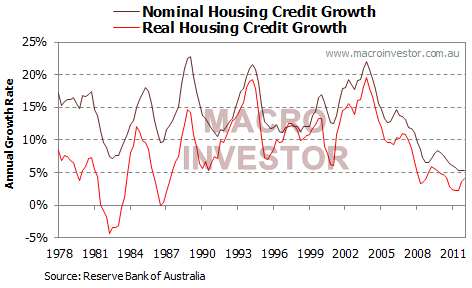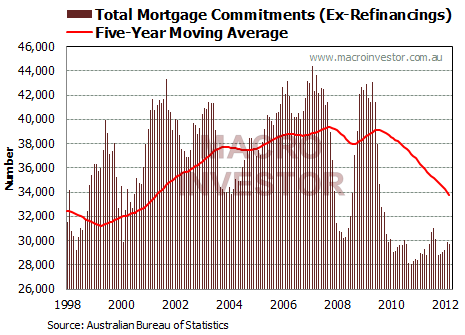
Recent weeks have seen a firming in Australian house prices and related indices, hinting at a Spring rebound for property. Is this happening and is it sustainable?
The first chart we can consult is the R.P.Data Daily House Price Index, which has firmed up since a bottom in early June:
There has also been a decent rise in auction clearance rates in the recent weeks, supporting a sense that momentum is building.
But against this, the growth and availability of credit, which is the fundamental driver of the housing market and is the real signal of a potential turning points, remains in the doldrums. In Australia, there are two key official sources of housing finance statistics:
- the Reserve Bank of Australia (RBA) credit aggregates statistics, which provides owner-occupied and investor mortgage data at the national level; and
- the Australian Bureau of Statistics (ABS) housing finance statistics, which provides detailed information on the number and value of housing finance commitments at the national and state levels, as well as information on average loan sizes and first home buyer activity.
The RBA credit aggregates is shown in the next chart in both nominal and real inflation-adjusted terms:

In nominal terms, mortgage credit growth in Australia is running at the lowest level experienced since the data series commenced in 1977 at just 4.7% in the year to July 2012. However, owing to the high rates of inflation in the 1970s and 1980s, real mortgage credit growth, while still subdued, is running near 25-year lows, having increased slightly over the past six months as the inflation rate fell.
The importance of this dataset cannot be underestimated. When credit growth is strong, house prices are more likely to increase in value as home buyers bid-up prices. By contrast, weak credit growth is more likely to be associated with falling house prices.
Since the GFC, this correlation has weakened a little and one possible explanation for why is that households with existing mortgages are repaying their loans quickly, which is offsetting some of the new mortgage debt being created, but is not affecting the number of new mortgages being taken out.
Another potential explanation is that housing transaction volumes have also fallen. As such, a smaller volume of mortgage credit is chasing a smaller volume of home sales, resulting in stable or moderately rising prices.
This brings us to the second key dataset on Australian mortgage credit: the ABS Housing Finance statistics which, among other things, provides a measure of commitments to purchase or construct dwellings for owner occupancy, and therefore indicates the strength of demand in the Australian housing market.
The key item to watch in this series is the total number of owner-occupied finance commitments excluding refinancings (dark grey line), since refinancing of existing loans does not represent a lift in the demand for established housing, and will have no direct impact on prices.
Focusing on this key data point only – total monthly owner-occupied finance commitments (excluding refinancings) – produces the next chart:

After bottoming-out in February 2011, the number of owner-occupied finance commitments (excluding refinancings) has risen by 6% to 29,743 mortgages as at July 2012. However, relative to the past decade, mortgage demand remains depressed, with total commitments (excluding refinancings) running -12% below the 5-year moving average (5YMA). The chart for finance commitments from first home buyers (FHBs) looks very similar, as does that for investors.
So, how is that prices are firming if these key data series remain so subdued?
There is one data point that shows a the RBA rate cuts of earlier this year is having an effect. Average loan sizes have risen in 2012 as the total value of mortgage commitments has decreased. This suggests that a smaller volume of mortgage credit has been chasing an even smaller number of transactions, with the end result being an increase in average loan sizes and, since home values are determined by actual transactions, we seen a recent rally in home prices.
It is questionable whether this new equilibrium is sustainable. New Zealand had a similar situation in force for a time between 2009 and 2011. This situation resolved when credit began to broaden again.
For Australia, however, the number of homes for sale nationally remains around 50% above what would usually be considered normal levels. A stalemate appears to have developed between would-be buyers that are refusing to pay higher prices, and stubborn sellers refusing to lower their expectations. Sooner or later, one side will capitulate, which will see transactions increase and prices head either higher or lower.
In the short to medium term, with the mining boom seemingly coming to an end – which will weigh significantly on incomes and jobs – the situation for house prices can best be represented as rate cuts versus a weakening economy. This could go either way depending upon the pace of the larger macro-economic shift.
But in the longer term, when we add the pending retirement of the large baby boomer generation – many of whom will be forced to sell property (and other assets) to fund their retirements – it is more likely that sellers will continue a steady capitulation, sustaining the slow melt in prices, especially in real terms.
Leith van Onselen is the chief economist at Macro Investor, Australia’s independent investment newsletter covering stocks, trades, yield and property. This is an excerpt from a special report on the developing trends in house prices. It is available as a part of a free 21-day trial. This is an op-ed run in the Fairfax press.

